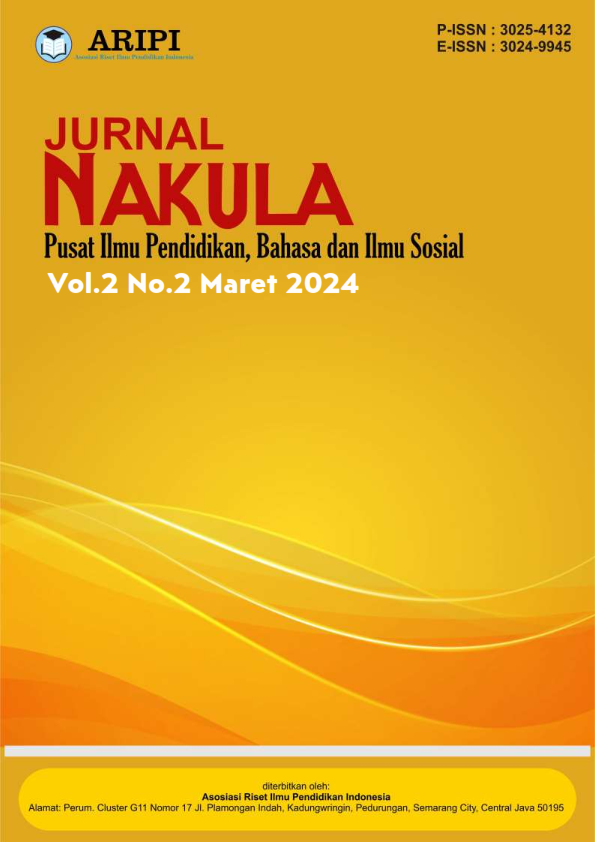Pendidikan Segregasi, Integrasi Dan Inklusi
DOI:
https://doi.org/10.61132/nakula.v2i2.550Keywords:
Segregation, integration, inclusionAbstract
Segregated education is an educational service that separates educational services between children with special needs and normal children, schools for children with special and normal needs. In the form of special schools and special primary schools. Integrated education is an integrated education service that unites children with special needs and normal children in the same class and at the same school as normal children. Integration education services are divided into regular classes, regular classes with special guidance rooms and special classes. And inclusive education services are educational services that are carried out in a sustainable, planned and directed manner to develop the potential that exists in children with special needs so that they can adapt to their environment. Inclusive education services have several educational service models such as the regular class model, cluster model, Pull Out model, cluster and Pull Out model, special class model and full special class model.
Downloads
References
Nurkholis. 2013.“Pendidikan dalam Upaya Memajukan Teknologi”. Jurnal kependidikan, Volume 1, nomor (1):25
Garnida, Dadang.(2015). Pengantar pendidikan inklusif. Bandung: PT Refika Aditama.
Baharun, Hasan, R. A. (2018). Berkebutuhan Khusus Dalam Perspektif. Program Studi
PGMI, 5 Nomor 1(3), 60.
Nazir, M. (2003). Metode Penelitian. Jakarta: Ghalia Indonesia.
Pratiwi, R.P., dan Murtiningsih, Afin. 2013. Kiat Sukses Mengasuh Anak Berkebutuhan Khusus. Yogyakarta: Ar-Ruzz Media.
Latifah, Ibdaul.(2020). “ Pendidikan Segregasi, Mainstreaming, Integrasi dan Inklusi”.jurnal pendidikan, Volume 29, nomor(2):105
Martin Iryayo dkk, Educational Partners Perception Towards Inclusive Education, (INKLUSI: Journal of Disability Studies, Vol. V, No.1, januari-Juni 2018), 26
Arif Maftuhin, Mendefinisikan Kota Inklusif: Asal Usul, Teori dan indicator, (Jurnal: TATALOKA Planologi UNDIP. Vol. 9, No. 2, Mei 2017), 94
Dieni Lailatul Zakia, Guru Pembimbing Khusus (GPK): Pilar Pendidikan Inklusi, (Surakarta: Prosiding Seminar Nasional Pendidikan, 21 November 2015), 110
Hasan Baharudin & Robiatul Alawiyah, Pendidikan Inklusi bagi bagi Anak Berkebutuhan Khusus dalam Perspektif Epistemologi Islam, (MODELING: Jurnal Program Studi PGMI, Vol. 5, No. 1, Maret 2018), 59
Stella Olivia, Pendidikan Inklusi untuk Anak-anak Berkebutuhan Khusus,(Yogyakarta: CV Andi, 2017), hlm. 2
Elisa, S., & Wrastari, A. T. (2013). Sikap guru terhadap pendidikan inklusi ditinjau dari faktor pembentuk sikap. Jurnal Psikologi Perkembangan dan Pendidikan, 2(01), 10.
Ghita, A. M., Wahyuningsih, W., & Ulfa, Z. (2017). MODEL PENDIDIKAN INKLUSI BAGI ANAK USIA DINI DI PAUD TERPADU PUTRA HARAPAN PURWOKERTO. Jurnal Penelitian Agama, 18(2), 356
Gunarhadi, G. (2017). ENHANCING LEARNING BEHAVIOR OF STUDENTS WITH DISABILITIES THROUGH PULL-OUT CLUSTER MODEL (POCM)(A CASE STUDY ON LEARNING PROBLEMS OF STUDENTS WITH DISABILITY IN INCLUSIVE SCHOOLS). Proceedings of the ICECRS, 1(1).
Nurussalihah, A. (2016). Implementasi pembelajaran pendidikan agama Islam terhadap anak berkebutuhan khusus di sekolah inklusi: Studi multisitus di SDN Mojorejo 01 dan SDN Junrejo 01 Kota Batu (Doctoral dissertation, Universitas Islam Negeri Maulana Malik Ibrahim).
David Wijaya, Manajemen Pendidikan Inklusif Sekolah Dasar, (Jakarta: Kencana, 2019), 27
Downloads
Published
How to Cite
Issue
Section
License
Copyright (c) 2024 Jurnal Nakula : Pusat Ilmu Pendidikan, Bahasa dan Ilmu Sosial

This work is licensed under a Creative Commons Attribution-ShareAlike 4.0 International License.





